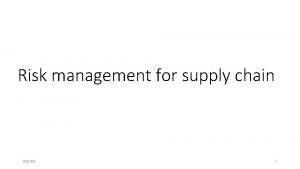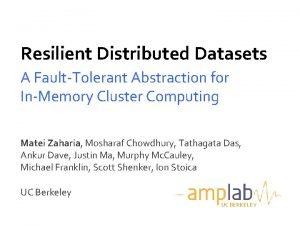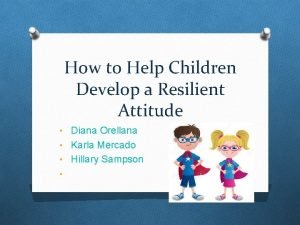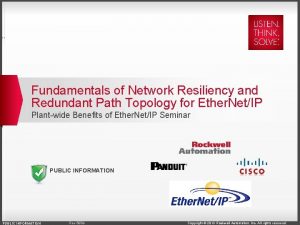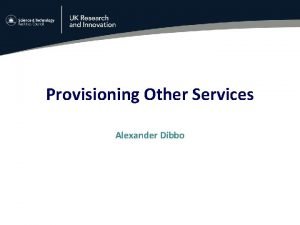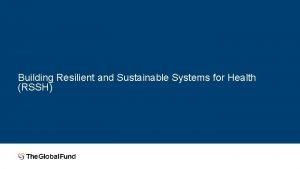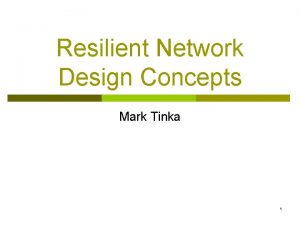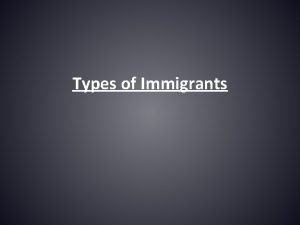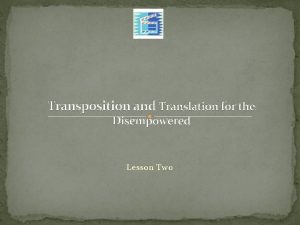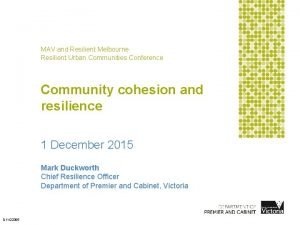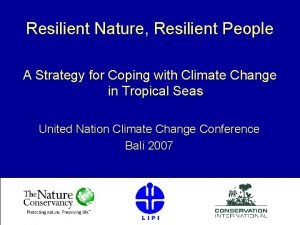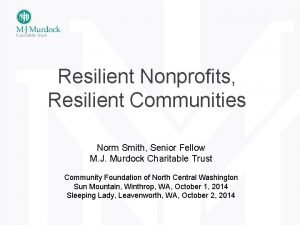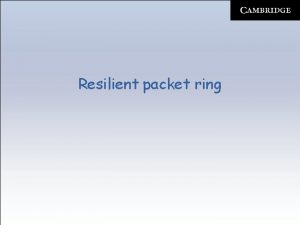RESILIENT IMMIGRANTS DISEMPOWERED SOCIETY A LOOK INTO IMMIGRANTS

![§ Integration = soft assimilation [public assimilation and private separation] § Acculturation as a § Integration = soft assimilation [public assimilation and private separation] § Acculturation as a](https://slidetodoc.com/presentation_image_h2/f867f32376059e8f69da1700062bbee0/image-2.jpg)










- Slides: 12

RESILIENT IMMIGRANTS, DISEMPOWERED SOCIETY? A LOOK INTO IMMIGRANTS’ ACCULTURATION EXPERIENCES Angela Fedi*, Terri Mannarini**, & Alessia Rochira** *University of Turin, **University of Salento ITALY Bratislava, December 3 -4, 2018
![Integration soft assimilation public assimilation and private separation Acculturation as a § Integration = soft assimilation [public assimilation and private separation] § Acculturation as a](https://slidetodoc.com/presentation_image_h2/f867f32376059e8f69da1700062bbee0/image-2.jpg)
§ Integration = soft assimilation [public assimilation and private separation] § Acculturation as a unidirectional process: immigrants are charged to adapt to their new contexts § The individual nature of the acculturative process: sociopolitical and collective factors (e. g. , law, racism) in the shadows

THE CURRENT STUDY §THEORETICAL MODEL: the Transconceptual Model of Empowerment and Resilience (TMER) (Brodsky & Cattaneo, 2013) §AIMS: To explore the role played by resilience and empowerment in the acculturation processes of Albanian and Moroccan immigrants settled in Italy §HYPOTHESES: (a) more resilience than empowerment in the immigrants’ experiences and actions; (b) 1 st generation immigrants more prone to resilience, 2 nd generation to empowerment §INSTRUMENTS: qualitative individual interviews aimed to understand their prior international experience, immigration history, experiences with RCMs , attitudes, and acculturation actions

PARTICIPANTS §Albanians - The largest of immigrant nationalities in Italy and also one of the most integrated, but for a long time one of the most stigmatized groups (King & Mai 2002). §Moroccans - The second largest immigrant population in Italy, they are currently the most discriminated group in Europe (Eurobarometer, 2015). Distant from Italian society as for cultural, linguistic, and religious characteristics (Gattino et al. , 2016; Giuliani & Tagliabue, 2015). Participants recruited through a snowball design, and contacted via local immigrants associations

ANALYSIS CODING FRAMEWORK – BASED ON THE TMER MODEL

RESULTS – DIFFERENCES BETWEEN GROUPS The notion of ‘fundamental risk’ “… not merely an elevated chance that certain aspirations and desires might not be obtainable, but rather the heightened probability that basic needs, rights, and access to resources will be thwarted by circumstances beyond one’s immediate control” (Brodsky & Cattaneo, 2013) § For Albanian immigrants (especially among 1 st g. ) the context of fundamental risk is their country of origin, characterized by poverty, women oppression, and political dictatorship §Moroccan immigrants have a different perception of risk in the Italian receiving society: they fear that they are at risk of losing their identity, and of being severely discriminated because of their diversity, and especially People their religion. treat us like strangers… just think what it is like for those who have just arrived. You speak Italian, you behave like them, you have the same aims, and even so you’re still a stranger. I’m scared to face this, also for my job. When I have an interview, I’m scared to death: They see me wearing the veil… what if they slam the door in my face? ” (2 G, F) If I go back to Morocco with my sons who are not able to speak Moroccan, how can they communicate with their family? This is the mistake Moroccans make, a great mistake. They make their children learn Italian and no more the Moroccan dialect (1 G, M)

RESULTS – DIFFERENCES BETWEEN GROUPS Change in the receiving context: community closure vs. community openness § Moroccan experiences: the economic crisis and social hardship have brought about an increase in ethnic prejudice §Albanian experiences: the Italian population has become less parochial and more cosmopolitan, and therefore more willing to accept diversity

RESULTS – SIMILARITIES ACROSS GROUPS §More resilience than empowerment, both in 1 st and 2 nd g. immigrants: more individual adaptation than context change, more status quo than status quake, more reflection than action §Resilience as a goal and as a reflection central in 1 g. immigrants’ experience § Discrimination substantially overlooked (infrequent and occurring in mild forms). Addressed through resilience strategies (internal focus), such as letting it roll off shoulders, or attributing it to ignorance of the person I don’t react, I judge the person, I usually think “it doesn’t matter”: that person didn’t travel, has little learning, so I forgive him/her, because […] that person is not educated, is narrow-minded… it’s better not to engage in a quarrel (1 G, F)

RESULTS – SIMILARITIES ACROSS GROUPS §Few signs of empowerment goals/actions, among 2 nd g. immigrants I’ve joined a group, I’ve applied for a training to increase my knowledge, to know what our rights are, so maybe I will be able to influence other people (2 G, M) §The core concept in in the acculturative experiences: adaptation § Both individual (language mastery, travelling experiences, cosmopolitan identity, self-confidence, selfdetermination) and social resources (social relationships in the host community and among compatriots) serve the aim of accommodation

SUMMARY § Resilient immigrants, endowed with psychological and cultural resources that make them capable of integrating into the receiving context § The more diverse the immigrant groups, the higher the risks faced in the receiving context § The main pathway to integration is via resilience, internal focus, and adaptation - Only in few 2 nd generation immigrants few signs of empowerment § Overall lack of political consciousness that could eventually result in empowerment

DISCUSSION § One-sided view of ‘integration’ that weighs resilience over status quake change § Different motivations for privileging resilience over empowerment ² Individualism, cultural closeness to the receiving context (Albanian experiences) ² Perceived risks, diversity (Moroccan experiences). This case fits the TMER model expectations: threats or fundamental risks call for resilience § Resilience in low risk conditions: not an immigrant-specific pathway § Effects: maintenance of an unjust status quo. Resilient immigrants = disempowered society? §

R U O Y R O F U O Y K THAN N O I T N E T T A References Brodsky, A. E. , & Cattaneo, L. B. (2013). A transconceptual model of empowerment and resilience: Divergence, convergence and interactions in kindred community concepts. American Journal of Community Psychology, 52(3 -4), 333 -346. Fedi, A. , Mannarini, T. , Brodsky, A. , Rochira, A. , Buckingham, S. , Emery, L. , . . . & Gattino, S. (2018). Acculturation in the discourse of immigrants and receiving community members. Results from a crossnational qualitative study. American Journal of Orthopsychiatry, 1 -41. Gattino, S. , Miglietta, A. , Rizzo, M, & Testa, S. , (2016). Muslim Acculturation in a Catholic Country: Its associations with religious identity, beliefs, and practices. Journal of Cross-Cultural Psychology, 47, 1– 7. Giuliani, C. , & Tagliabue, S. (2015). Exploring identity in Muslim Moroccan and Pakistani immigrant women. Europe's Journal of Psychology, 11(1), 63. King, R. , & Mai, N. (2002). Of myths and mirrors: interpretations of the Albanian migration to Italy. Studi Emigrazione, 39(145), 161 -200.
 Look up, look down, look all around
Look up, look down, look all around Old immigrants vs new immigrants
Old immigrants vs new immigrants Supply chain risk register
Supply chain risk register Resilient distributed datasets
Resilient distributed datasets Torpedo traffic generator
Torpedo traffic generator Resilient attitude
Resilient attitude Resilient ethernet protocol (rep)
Resilient ethernet protocol (rep) How can more resilient
How can more resilient Feature vectors
Feature vectors Resilient and sustainable systems for health
Resilient and sustainable systems for health Resilient network design
Resilient network design Great oiled resilient striding legs analysis
Great oiled resilient striding legs analysis Cisco ios resilient configuration feature
Cisco ios resilient configuration feature


